Over the past five days, South Korea has endured an unprecedented monsoon assault. Torrential rains since Wednesday dumped staggering amounts—up to 800 mm (31.5 inches) in areas like Sancheong County alone. In Seosan, the intensity was so fierce that 114.9 mm fell in just one hour, marking a 100‑year weather event
Regional impacts include:
ImSancheong (South Gyeongsang) 793.5 mm of rain, triggering landslides that destroyed homes and temple structures, including damage to Yulgok Temple’s Daeung Hall—a designated cultural treasure Hapcheon and Hadong: Each received over 600 mm of rain, causing widespread flooding and mudslides Broader Chungcheong and Jeolla: Recorded 400–500 mm in just two days, hampering transportation and safety infrastructure
Human beings Toll and Evacuations
Casualtiess:
17 confirmed dead, 11 missing (overall figure) as of July 20
In Gapyeong (east of Seoul), a landslide buried houses and campsites, resulting in at least two deaths and five missing people
In Sancheong, eight deaths have been confirmed, with six still unaccounted for
South Chungcheong and Gwangju also saw fatalities from flash floods and submerged vehicles
Evacuations and Disruptions:
Over 13,000 residents evacuated nationwide, with around 2,730 households still displaced by Sunday afternoon
Infrastructure damage includes 1,920 cases of public property loss and 2,234 cases of private damage (homes, farmland)
In Seosan and Gwangju, flooded roads, submerged buildings, “once-unseen” household inundation, and power outages affected thousands of residents
Cultural and Environmental Damage
I’m At least eight cultural heritage sites were damaged, including Daeung Hall at Yulgok Temple and traditional houses in Boseong and Songgwang Temple trails in South Jeolla .
The Bangudae Petroglyphs (UNESCO‑listed) in Ulsan were completely submerged as dam water levels exceeded thresholds—an event not seen since August 2023 .
Government Response and Climate Context
President Lee Jae Myung launched emergency assessments and called for the fast designation of special disaster zones, unlocking additional aid and financial support to affected regions
The Ministry of Interior and Safety raised landslide alerts and extended evacuation responses across high-risk zones; major infrastructure projects and early warning systems have since been reinforced
Climate Implications:
South Korea’s monsoon system (“Changma”) is shifting: while overall average rainfall during monsoon periods may be decreasing, the occurrence of sudden extreme rainfall (30 mm+/hour) is increasing—consistent with broader climate change patterns
Key Takeaways and Looking Ahead
✔️Summary:
Extremely heavy rainfall across southern and central regions.
17 dead, 11 missing, and widespread evacuations.
Severe damage to homes, infrastructure, cultural heritage, and heritage sites.
Government relief efforts accelerated with special disaster zone designations.
What We Can Learn:
Existing hazard maps must be updated frequently, especially for landslide-prone hillsides and underpasses.
Community preparedness and evacuation protocols remain critical—not just during moderate monsoons but for extreme flash-flood events.
What Happens Next:
Rain is expected to subside by Sunday, likely followed by a heat wave affecting the same regions previously drenched. Yet with such saturation, landslide risk remains, and authorities caution residents to remain vigilant.
South Korea’s recent monsoon disaster stands as a stark reminder that even countries accustomed to seasonal floods must adapt to increasing extremity in climate patterns. Communities, governments, and emergency systems must all evolve to meet the challenges posed by a changing environment.
READ ALSO:👇👇
Ghana-takes-crucial-step-to-reform education scholarships
Ghana-scraps-fuel-allowances-for all appointees






0 Comments